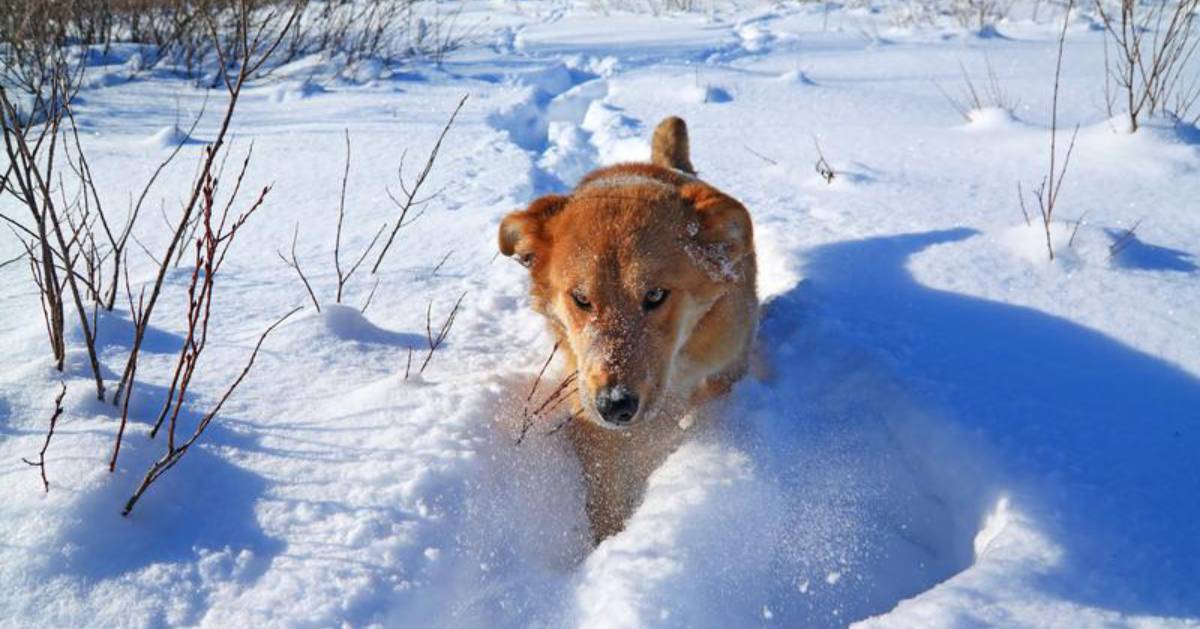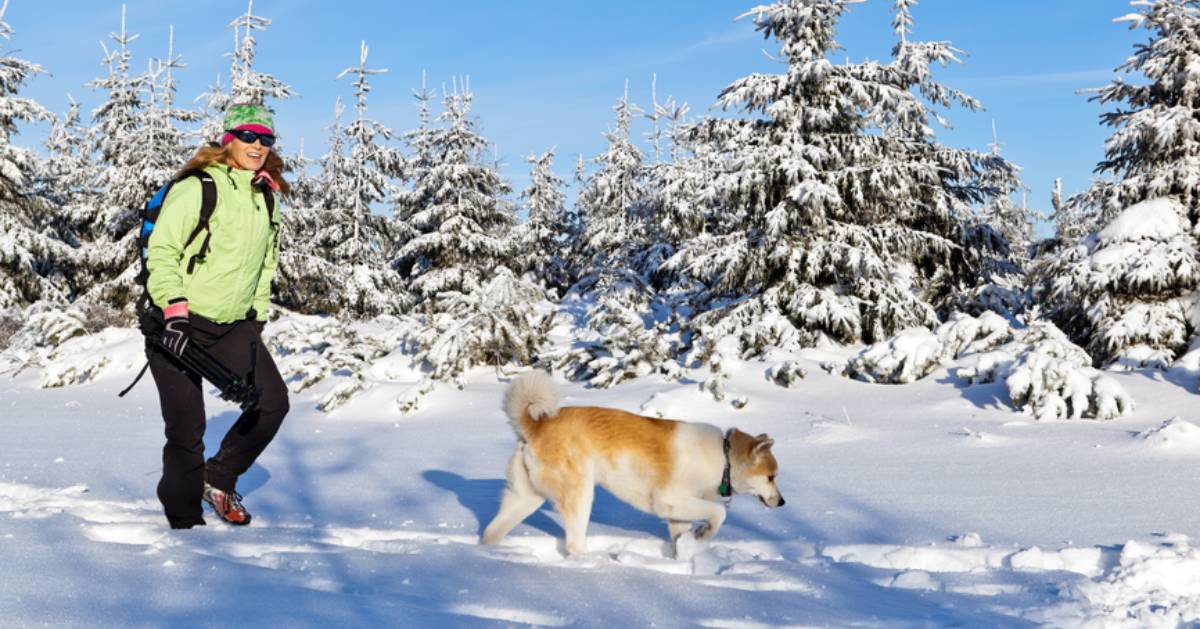Essential Tips for Hiking With Your Dog in Winter
Garnet Hill Lodge offers options for both activity and relaxation. Spend the day exploring the cross-country ski and snowshoe trail network, then retreat to the cozy Log House to warm up by the fire. Ski passes are included with overnight stays! Learn More »
Enjoy adventures with your dog all year long! If you've never been on a winter hike with your furry friend, or you just want to read up on some quick safety tips to know, check out our info below.

Getting Started: Your Dog's Breed, Health, Age & More
During the winter season, trails may be slippery and/or covered in snow, making for a tougher - and longer - hike than in warmer seasons. It's essential that your dog is physically fit enough to handle trail conditions.
The second aspect to consider is your dog's breed. Dogs with a thick coat, such as a Siberian Husky, thrive in cold temperatures and enjoy the snow. Short-haired dogs, or breeds without an undercoat like Pugs, will get cold faster and may not take to being outside for too long.
In general, puppies and our older canine friends should not be going on winter hikes. Not only does the cold affect them faster, but wading through deep snow can cause injuries. Research your dog breed, and find out how protective their fur coat is.
Where Should I Bring My Dog Hiking?
Don't forget to check the trails before you go (bookmark our Current Conditions page, updated with trail conditions and new notices every week) and keep in mind dogs with short legs will get tired quickly on routes covered in deep snow. Try to stick to a trail that only has a few inches on it. Always turn back if you need to.
For specifics, we recommend Baker Mountain (considered a great beginner snowshoe mountain) or Pitchoff Mountain (moderate, not terribly difficult in the winter). But again, it's a matter of knowing your dog and paying attention to the weather and trail conditions.
How Long of a Hike Should I Bring My Dog On?
If your dog is used to short hikes in the summer, start with a short winter hike. You can always build up to a longer trip once your dog gets used to the conditions. If the temperature is below freezing a short walk is recommended for most dogs - about 10 to 15 minutes.
When the temperature is above freezing you can go for a longer, 30-to-45-minute hike. If you dog can handle the cold for a longer period of time, you can extend the trip, just don't forget to take frequent breaks.

How Do I Know if My Dog is Cold?
If you feel cold, a dog with a less-than-protective coat will also feel cold. We all bundle up to protect ourselves from the cold weather, but did you know dogs can also get frostbite and hypothermia? It's true, and the dogs most likely to develop these problems are short-haired dogs, puppies, and elderly dogs. While larger dogs and breeds with thick fur coats are less likely to be affected, the cold can still be uncomfortable if your dog is not used to it. As such, you should know the signs for when a dog is too cold:
- If your dog begins whining or barking while on a hike for seemingly no reason
- If your dog constantly stops on a hike
- If your dog is noticeably shivering, then it is time to stop the hike and go back
- If your dog gets anxious and starts looking for a shelter
- If your dog has very cold paws, nose, ears, or tip of the tail, or if you see discoloration in those areas, it may be an early sign of frostbite
What Do I Need to Bring On a Winter Hike?
In addition to being properly prepared yourself, you'll want to pack stuff for your dog too. You should pretty much bring the same items as usual, with a few additional considerations.
You'll want water and a collapsable bowl (it's important to stay hydrated in the winter, too, and eating snow is not sufficient), doggy bags, and appropriate treats. Keep in mind some treats can be difficult to eat in cold weather. Try carrying your dog's treat pouch on your person instead of in a backpack.
Also, bring a blanket or a portable dog bed for your dog to relax on/eat treats/drink water during breaks. And yes, you may need dog booties and a sweater or jacket.
What About Dog Booties or a Sweater?
You've probably seen dogs with one or the other and wondered if your pet needs them too. While dog booties and sweaters/jackets are not 100% necessary for your dog to survive in the cold, they can be helpful as long as you know how to use them properly.
Dog Booties - They may look a little silly on your companion, but they do serve a purpose. When your dog has long hair around their paws, snow can get stuck there and cause extreme irritation. To prevent these snowballs on your dog's paws, some owners have their furry friend wear booties. Booties are basically a sock with a strap to keep them attached to the paw. They protect paws from snow, salt, and other de-icers.
Some dogs won't like wearing booties, so it may take some time before they get used to them. If you want to try booties, you should pick a size that isn't too tight but can be made snug so it doesn't fall off. You don't want to cut off your dog's circulation.
Dog Sweaters/Jackets - Dog sweaters and jackets can help keep short-haired dogs warm in cold temperatures. Conversely, sweaters and jackets can overheat a larger dog with dense fur because their own coat is protective enough.
If you want to purchase a sweater or jacket for your dog, pick out one that won't drag on the ground, fits snugly but isn't too tight, and doesn't have anything that could be caught or torn off (zippers, hooks, buttons, tags, etc.). Make sure your dog's legs are free to move, and if possible, bring your pet to the store to try it on.
The most important thing to remember with a sweater or jacket is that if it gets wet, you should remove it. You don't want your dog outside in winter with wet material on them.
Be Wary of Waterbodies & Avalanche Terrain
Winter hiking hazards to humans like a partially frozen waterbody or an avalanche are also problematic for our doggie friends. Be aware of your surroundings at all time and avoid ice if at all possible unless you're 100% sure it's safe.
In addition, research avalanches through the DEC or other sources and how to avoid them and self rescue should you need to; you could even take an avalanche course. The risk of avalanches increases during and after major snowfalls and thaws.
A Final Tip: Rules & Etiquette
Research where you're hiking ahead of time so you can be sure dogs are allowed (the Adirondack Mountain Reserve for instance does not allow dogs) and what the leash law is; these are in addition to researching the hike and trail conditions itself to ensure you and your dog are ready for the excursion.
Only bring your dog on the trails if they are well-trained and obedient. Be respectful of other hikers and know that some may not like dogs as much as you do. Always clean up after your dog. Try to keep them from disturbing local scenery and wild animals.
Find more in the Hiking With Dogs Guide »
« Back to the Winter Hiking Guide
Sources:
- http://www.petmd.com/dog/seasonal/evr_dg_sweaters_for_dogs
- http://www.active.com/outdoors/articles/5-dog-safety-tips-for-winter-hikes
- http://dailydogscoop.blogspot.com/2009/10/winter-hiking-safety-for-your-dog.html
- http://pets.webmd.com/features/pet-winter-safety-prepping-your-pet-for-winter-weather
- http://www.embracepetinsurance.com/seasonal/dogs-and-cold-weather
- https://visitadirondacks.com/hiking/hiking-with-dogs
- https://www.zukes.com/dog-blog/8-tips-for-winter-hiking-with-your-dog
